
The Internet's Premier Classical Music Source
Related Links
- Latest Reviews
- More Reviews
-
By Composer
-
Collections
DVD & Blu-ray
Books
Concert Reviews
Articles/Interviews
Software
Audio
Search Amazon
Recommended Links
Site News
 CD Review
CD Review
Adolphus Hailstork

Symphonies
- Symphony #2
- Symphony #3
Grand Rapids Symphony Orchestra/David Lockington
Naxos 8.559295
A virtually unknown contemporary composer, a little-known conductor and a supposedly second-tier orchestra – the recipe for success? You can't judge a book by its cover and, in this case, a CD by its seemingly modest offerings. This Naxos issue may contain unusual ingredients, but its success on virtually all counts is undeniable.
Adolphus Hailstork is on the faculty at Old Dominion University and a seasoned composer, the author of three symphonies, various orchestral and chamber works, operas and many other compositions. On the basis of this CD, I'd say he might well be ranked a major figure among American composers. Born in 1941, Hailstork studied with Nadia Boulanger, David Diamond, and Vittorio Giannini, among others. His orchestration is assured, and his style shows the influence of Diamond, Giannini, Copland and other, mostly American composers. I would say that if you like Howard Hanson's music, you will find Hailstork's most enjoyable. But don't let me mislead you – Hailstork has fashioned his own style: his music is accessible even when it is serious and dark in mood; his textures come across more clearly than Diamond's or Copland's, for example; his melodies and harmonies are easily grasped; and his ability to convey an unusual or exotic mood is most telling.
The disc leads off with the four-movement Symphony #3, a work commissioned by the Grand Rapids Symphony in 2003. It is a light composition, filled with catchy themes – especially the opening trumpet tune – and snappy rhythms. This piece could enter the standard repertory – it's that good! Listeners interested in American music will find it colorful, brilliantly orchestrated and very busy. The Symphony #2 (1995-98), also cast in four movements, is a more serious work. The composer informs us the second movement was inspired by sites he encountered on a visit in 1996 to Ghana, where he viewed dungeons used as holding cells for slaves about to be transported abroad. Hailstork's sense of angst is more direct and less complex here than that found in, say, Mahler's symphonies. The music is powerfully atmospheric, conveying a feeling more altruistic in character than personal, more programmatic or cinematic than symphonic: you see the slaves and feel their agony. Most listeners may favor the lighter, more immediately appealing Third than Second Symphony. I won't choose one over the other for artistic merit, but will say both are worthwhile creations. Hailstork is a real find, the genuine thing.
David Lockington leads the Grand Rapids Symphony with insight, effectively capturing the essence of both pieces. His orchestra performs admirably throughout, and the sound reproduction is vivid. For those interested in American or conservative contemporary music, this disc will not disappoint. Highly recommended!
Copyright © 2007, Robert Cummings




















